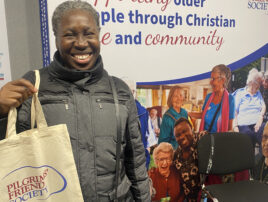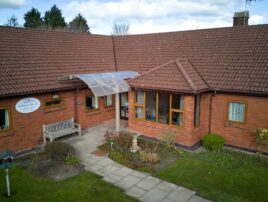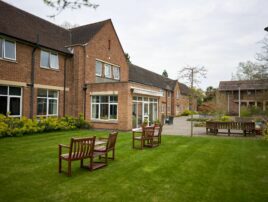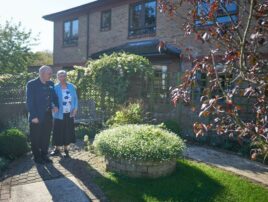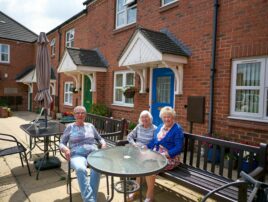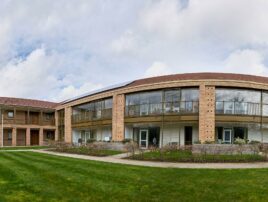Thursday 14th March 2024
Lifting the lid on memory boxes
Across our care homes, multi-sensory memory boxes are bringing joy and comfort to people living with dementia, as Jo, our The Way We Care Lead at Middlefields House, Chippenham, explains
“We’ve all done it – walked into a room and thought ‘what on earth have I come in here for?’. So imagine how it might feel to experience that sense of disorientation regularly throughout the day. For people living with dementia, life can be a bit like that, especially as the condition progresses.
“That’s why prompts such as memory boxes can be so helpful. Contained within a simple shoebox, each person has a carefully collated selection of objects, chosen to evoke memories and associations that are personal to and reassuring for them.
“Our The Way We Care approach is all about caring for people as individuals – the better we know a person, the better we can care for them. Memory boxes are one of the ways we put that into practice and getting the details right is vital. You may know that someone was a teacher and think of putting in some chalk. But if you don’t know that they hated teaching you could end up stirring up negative emotions instead.
“At Middlefields House, we’ve been seeing the benefits of memory boxes for our family members. One person for whom a memory box has been very helpful is Brenda. She can experience high levels of anxiety due to her dementia, saying things like ‘where am I?’ and ‘I’m frightened’ anything from 15 to 25 times a day. Through talking to Brenda and her niece and nephew and by drawing on details of her life history, I’ve been able to fill a memory box with objects that tap into different senses, including smell and touch, which remain strong where others may fade.
“Inside Brenda’s memory box are photos of The Congregational Chapel in Atworth which is very important to her. Particularly lovely is a photo of her celebrating her 90th birthday with the whole congregation. There’s also a bar of coal tar soap which she has used all her life, little feathered birds that remind her of the canaries she used to keep, a sprig of leylandii from the tree in her front garden and a pinecone figure, part of her collection from the Black Forest area of Germany where she enjoyed going on holiday.
“It’s incredible to see the effect these objects can have on Brenda. Often she’ll sit holding them for a while and it’s almost as if you can see the cogs turning as the memories return. She’ll become much calmer and then, with a little gentle prompting, she’ll begin to talk, sometimes with amazing levels of detail.
“For example, the other day looking at the picture of the chapel sparked a whole train of memories about her life in Atworth. She told me that she’d lived in the same house in Atworth for 90 years and that it used to have one name but then the address was changed to another name and street number. She told me all about how as a child she’d play in the streets right outside her house.



“Across the staff team, everyone has been commenting about how useful the memory box has been for Brenda, giving them a way in to talking to her about things they know she will find soothing. Our Hummingbirds especially have been able to make use of it with her as their role involves making short meaningful connections.
“We keep the memory boxes in each person’s room and they can be brought out when needed. Relatives and volunteers are also very welcome to use the memory boxes when visiting.
“Another person for whom we have made a memory box for is Alec. His memory box contains a lot of photographs, holiday brochures and postcards as it’s visual things that really resonate for him, rather than things that tap into the other senses. He was a civil engineer, working on dams and bridges, and so he has a real eye for details. However, this isn’t so much reflected in his memory box. It was the people in his life and places he went with them that are deeply meaningful to him and so his memory box reflects that. Again, it all comes down to knowing the individual.
“As with Brenda, we’ve seen how this memory box can be very powerful. Alec can very easily slip into echolalia but with the support of his memory box he will tell you all about the people in the pictures and engage in meaningful conversation.
“Another component memory boxes may have is a person’s favourite Bible verses or the words of hymn they like. This could be used as prompt for something to sing or listen to on YouTube. Having a handheld cross to hold or beads can also help to bring spiritual comfort for our family members.
“As part of The Way We Care, we’ve recently started Family Matters sessions where relatives and loved ones of those living with us are invited to find out more about our approach to care and play an active part in the process. At a recent session, I shared with them about memory boxes and as an example I showed them a box I could have created for my own father who passed away from dementia a couple of years ago.


"This box has golden wrapping paper decorated with stars as my dad loved astronomy. Inside there’s a photo of my mum and dad on holiday in Cornwall, a Lego minifigure because whatever he was doing he would always have time to stop and build Lego with his grandchildren, a cassette tape for a favourite song by Mariah Carey, a knobbly volcanic rock from Greece, some thread that’s the same colour as a shirt he wore that Mum hated and threatened to throw away, a children’s illustration that he was given for his fourth birthday, a coaster with the logo of Ind Coope Brewery where he used to work, an antique eye bath and a book by Gerald Durrell.
“In some ways, making this box was a little bit sad as I know how much my dad would have enjoyed looking through and talking about these objects if he’d had it when he was alive. It also brought home to me how important the process of making a memory box can be for relatives as well. Sometimes a person’s dementia can be so all-consuming that you get to a point where you can’t see past it. Thinking about a person’s history and the things they love can help bring them back into view, like making a pixellated photo clear again.
“Having the relatives play a part in making a memory box is so important, ensuring we get the details right. At Middlefields House, we have 48 family members and so making one for everyone is a big job. The help of relatives in feeding into this process is very much appreciated! A memory box is also something that can grow over time. If some objects are not really working or we find out new things, we can always change the selection.”
Find out more about The Way We Care

The Way We Care
Our unique approach to ensuring that older people have all that they need to flourish in their later years

Family life
We’re committed to creating warm and sharing communities where everyone has opportunities to contribute to family life

A place for everyone...
How personalised placemats are transforming mealtimes for family members at Milward House, our care home in Tunbridge Wells




